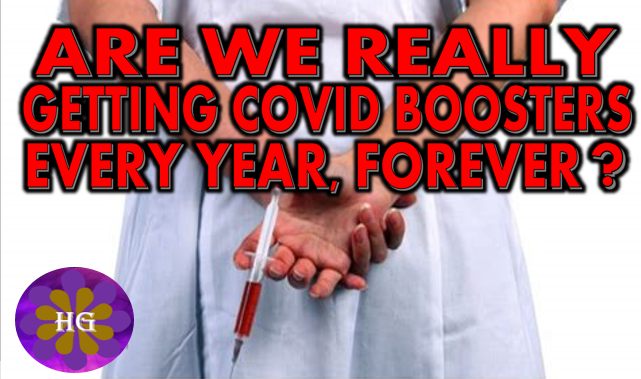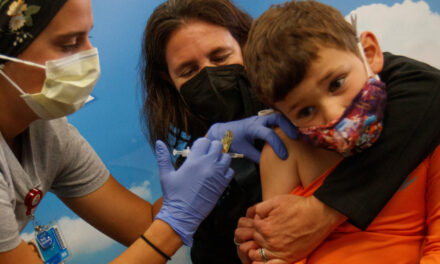Prepare yourself for a lifetime of fall vaccine campaigns. The following is an article by Jacob Stern giving us all a visual of what the future looks like.
School is in session, pumpkin spice is in season, and Americans are heading to pharmacies for what may soon become another autumn standby: your annual COVID shot. On Tuesday, the White House announced the start of a “new phase” of the pandemic response, one in which “most Americans” will receive a COVID-19 vaccine just “once a year, each fall.” In other words, your pandemic booster is about to become as routine as your physical exam or—more to the point—your flu shot. One more health-related task has been added to your calendar, and it’s likely to remain there for the rest of your life.
From a certain standpoint, this regimen makes a lot of sense. The pandemic’s biggest surges so far have come in the winter, and a fall booster could go a long way toward mitigating the next of those surges. What’s more, the new plan greatly simplifies COVID-vaccination regimens, both for the public and for providers. “It has been bewildering in many cases to understand who is eligible for a booster, how many boosters, when, which boosters, how far apart,” Jason Schwartz, a vaccine-policy expert at Yale, told me. “I think that has held down booster uptake in some really discouraging ways.” In a sense, White House COVID-19 Response Coordinator Ashish Jha told me, the new plan just codifies the way things already worked: The last time low-risk Americans became eligible for another shot was last fall. (The elderly and immunocompromised have operated on a different schedule and will likely continue to do so, Jha said.)
Still, some public-health experts worry that the White House is jumping the gun. Back in April, a number of them told Stat News’s Helen Branswell they were concerned that the U.S. would adopt such a policy without the data needed to support it. When the White House made its announcement on Tuesday, many felt their concerns had been vindicated. “We’ve had twists and turns and surprises every single step of the way with COVID, and the idea that we’re going to have one shot and then we’re done is not really consistent with how things have worked in the past,” Walid Gellad, a professor at the University of Pittsburgh School of Medicine, told me. The plan, in his view, glosses over considerable uncertainties.
For one thing, it assumes that the virus will follow an annual schedule with peaks in the fall and winter—not unlikely, but also not a given. For another, we still don’t have a firm grasp on the magnitude or duration of the benefits offered by the new Omicron-specific vaccine. For all we know, Gellad told me, the added protection afforded to someone who gets the shot tomorrow may have largely dissipated by New Year’s Eve.
And that’s not to mention the massive uncertainty presented by the specter of future variants. In a briefing Tuesday, Jha acknowledged that “new variant curveballs” could change the government’s plans. But the announcement itself includes no such caveats, which some public-health experts worry could cause problems if course corrections are needed down the line. For all we know, new variants could necessitate more frequent updates, or, if viral mutation slows, we might not even need annual shots, Paul Thomas, an immunologist at St. Jude Children’s Research Hospital, in Tennessee, told me.
If the routine the White House describes sounds a lot like flu shots, that’s no accident. The announcement explicitly recommends that COVID vaccines be taken between Labor Day and Halloween—“just like your annual flu shot.” That comparison, though, is part of what concerns critics, who worry that the shift into a more flu-like framework will entail the adoption of a vaccines-only approach to COVID prevention. Many of the interventions that have proved so effective over the past two and a half years—masking, distancing, widespread testing—have not traditionally been a major part of our flu-season protocols. If we treat COVID like flu, the thinking goes, such interventions risk falling even further by the wayside. The announcement, which makes no mention of any other prevention tactics, doesn’t offer much reassurance to the contrary.
But that reading, Jha told me, is “just clearly wrong.” Although vaccines are “the central pillar of our strategy,” he said, testing, masking, and improving indoor air quality are all important as well. But as my colleague Katherine Wu has written, the country has been relying more and more on vaccines—and less and less on the other interventions at our disposal—for some time. Even if you do read the new policy as an abnegation of masking, ventilation, and the like, it may not functionally be much of a departure from the status quo
For now, Thomas said, the White House’s plan makes sense—as long as it stays sensitive to changing circumstances. “We keep learning new things about this virus,” he told me. “The rate of mutation is changing. The spread through the population is changing.” And as such, he said, our response must be flexible.
The White House announcement seems like a good-faith attempt to balance competing priorities: on the one hand, the need to communicate uncertainty and acknowledge complexity; on the other, the need to keep the message from getting so complex that it confuses people to the point they tune it out entirely. In this case, the administration seems to have come down on the side of simplicity. That could be a mistake, Gellad says—one that public-health authorities have made over and over throughout the pandemic. “When you try and make things simple and understandable and present them without sufficient uncertainty,” he told me, “you get into trouble when things change.”
Source Link: https://www.theatlantic.com/health/archive/2022/09/do-we-need-annual-covid-booster-shot/671381/
Bitchute: https://www.bitchute.com/channel/YBM3rvf5ydDM/
Telegram: https://t.me/Hopegirl587
EMF Protection Products: www.ftwproject.com
QEG Clean Energy Academy: www.cleanenergyacademy.com
Forbidden Tech Book: www.forbiddentech.website













